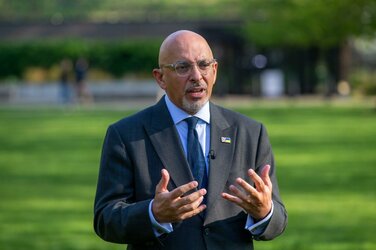https://www.thetimes.co.uk/article/...ls-are-struggling-with-trans-rights-7068kn350 | Archive
Teacher reveals how schools are struggling with trans rights
Worried parents, angry teens and furious battles over pronouns. An experienced teacher lifts the lid and explains why he had to leave his job
Sian Griffiths
Saturday May 21 2022, 6.00pm BST, The Sunday Times
For many people, the story that emerged last week of an 18-year-old girl who expressed doubts about ‘‘transgender ideology” and was bullied out of school by her peers was no doubt a shocking one. The girl, who wants to remain anonymous, says that she was “treated like a heretic” after she questioned a female member of the House of Lords who had come to the school to speak about transphobia in parliament. The visitor used language that the girl believed implied critical theory took precedence over biological reality in defining women. The incident prompted her fellow pupils to turn on her — she claims that a crowd of up to 60 girls screamed, swore and spat at her. She has since left the school.
JK Rowling and the education secretary, Nadhim Zahawi, have come out in support of the girl, whose case was made public by a whistleblowing teacher. Rowling criticised schools for pandering to quasi-religious fanaticism; Zahawi said her treatment was “hugely concerning”; and invited teachers with similar concerns to come forward.
While it is undoubtedly an extreme example, the story is also evidence of something that teachers like me know to be true: that gender politics is causing chaos in schools around the country, leaving staff and pupils afraid to express their views.

JK Rowling has backed a pupil bullied out of school over her views on trans matters.
I have been a teacher for more than a decade and, until recently, was a science teacher at a secondary school in Oxfordshire. I was also head of year 9, responsible for the pastoral care of about 150 pupils aged 13 and 14 while managing a team of teaching staff who worked with them. It was a job I enjoyed and believe that I did well.
Last spring I was asked to handle the case of a year 9 student who was questioning her identity; she no longer wanted to be called by a girl’s name and asked to be addressed using the pronouns they and them.
This was not the first such incident at the school. There was an older pupil who had been born female and had in effect transitioned — and was already being called by a boy’s name.
The school had no clear written policy about what to do in such cases. My first response was to pick up the phone to the year 9 girl’s home. I rang her mother to try to find out more about the background; had the teenager spoken about not wanting to be treated as a girl? It turned out that it had been aired and a therapist had been brought in.
The child’s mother said there was an explicit instruction from the therapist that she continue to be called by the name she was given at birth and addressed as female. There was a belief that there were other psychological issues to explore and the mother said it was imperative the school follow the same line as was being taken at home.
I relayed this to the teachers dealing with this particular child and explained the reasoning behind it. I said we could not stop her friends from calling her a different name in school because that was too complex to grapple with but as teachers we would use the legal name that was on the register.
My colleagues agreed, but soon after some members of the teaching staff began to experience hostility from the pupils. The child’s class tutor, in particular, was targeted. One day he walked into class to find that water had been poured all over his chair. On another occasion he found the word “transphobe” scrawled on the whiteboard. There were other outrageous incidents: he was constantly heckled in class for “misgendering” her by using the “wrong” pronouns, behaviour that was difficult and disrespectful.
The tutor in question was experienced but even so he was taken aback, concerned enough to tell me what was happening. I decided to have a sit-down with some of the pupils and hold what the school calls a “restorative conversation” — a discussion where both sides just air their point of view.
The children arrived prepared: they said they had watched TikTok videos and clips on other social media sites where films suggest that you can change sex, that there are many different genders, that it is cruel to deny a child who feels as though they are in the wrong body.
We tried to address the situation calmly. I have no ideological position on the issue and felt that it would have been wrong to come down too hard on either side. We explained that the problem was not that the teaching staff did not believe the pupils, but that there were complicated matters to consider, that the person you believe you are now may not be the person you want to be in ten years’ time and that decisions made now could have longer-term ramifications. I also explained that it was not the school’s place to override a parental decision.
The issue of gender identity is an incredibly hard one for teachers to manage and the questions involved are highly complex: should children be allowed to transition without a parent’s consent? What if they are under 16? How should we handle the knock-on situations this raises for sports, school trips, changing rooms?
I know from friends working in schools in Essex and Northern Ireland that this is what they are dealing with day to day and doing so in an atmosphere that is highly charged: no one wants to be called a bigot by the children in their class.

Nadhim Zahawi, the education secretary, said the treatment was “hugely concerning”
At the end of the meeting I felt there was an understanding from the pupils that we were not being cruel, we were simply saying to her: take it slowly, you are only 14. Nevertheless, I decided to raise the issue with my line manager, who was also in charge of safeguarding, who suggested I raise it with the head teacher.
The head took a different view to mine. He saw no reason not to do what the child wanted. I explained that I had no ideological axe to grind but felt uncomfortable about disobeying a parent’s request. We discussed it and I agreed to leave it with him while he deliberated the right path to take. In the meantime we agreed that the teaching staff would continue to use the child’s female pronouns.
Over the course of the year, however, I got a few calls from the mother complaining that some teachers were calling the girl by the name she had requested. The girl would take her books home and her chosen name would be written on the front of them. The mother was concerned and said she was being ignored. I could see her point. But the staff were reluctant to face the continuing resentment from pupils in the class.
There had been a bit of a cultural shift in the school by this point. The sixth form lavatories were redone and were made unisex. They were labelled “gender neutral”. There was some talk about painting the bollards in rainbow colours to signal LGBT awareness too. The school already had a mix-and-match uniform: girls could wear trousers or skirts.
Now the issue began to bubble up more frequently in personal, social, health and economic education and science lessons too.
Some teenagers would say: “Why can’t I be non-binary or why can’t I be a boy?” Children seemed to feel emboldened, absolutely certain that there was only correct point of view. The school seemed to be reinforcing this. If a teenager questioned the prevailing view among their peers and said: “You can’t just become a boy, you can’t change your sex”, then they could be sent to the pastoral hub and it might be suggested they undertake an LGBT course.
Around the same time, more children in the lower years were starting to question their gender identity. It began to feel like a social contagion was spreading through the school.
Eventually I decided that it was time to move on. I kept quiet until I had a new teaching job — I knew I would need a reference. Then I aired my concerns in my exit interview. The head listened but pointed out that the changes in the school had been welcomed by some LGBT pupils who had told him how much they appreciated them.
I don’t blame the school for its chaotic approach; the arguments about gender identity and biological sex have become a fearsome culture war. Teachers lack the training and information to cope. Like most parents facing the same questions, they are afraid of doing something that is not in a child’s best interests.
That is why it is imperative that the Department for Education (DfE) gives clear guidelines for schools on how to tackle this problem; it should be a policy that is evidence-based and universal. That is the only way to calm the anger bubbling up in classrooms and to allow teachers to get on with their jobs.
I chose this profession because I wanted to impart knowledge; that’s about more than teaching my subject, it’s considering a child’s wellbeing and their mental health too. I believe that most teachers feel the same way. But in the current climate, this is becoming increasingly hard to do.
We are under instruction from the DfE to teach British values and to teach tolerance in particular. The idea that it is transphobic to suggest that sex and gender are different and to howl down opposition is not tolerant, nor is it tolerant to brand a teacher transphobic or to bully a pupil out of school.